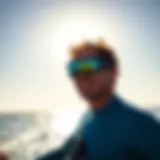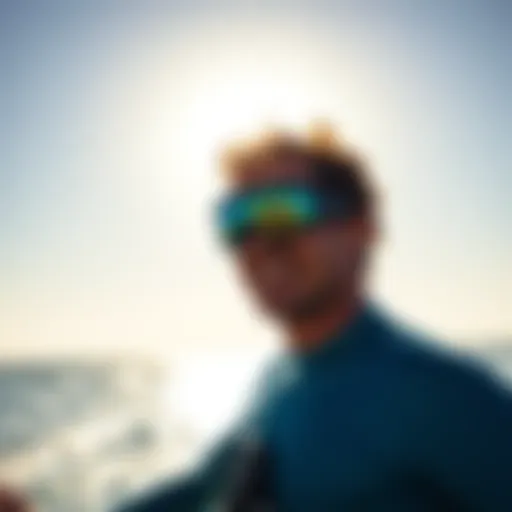E-Foil: Transforming the Future of Water Sports
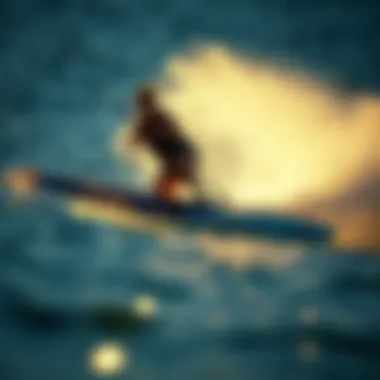

Intro
The world of water sports is not just about the thrill of riding the waves; it’s also about embracing new technologies that redefine the experience. In recent years, e-foiling has emerged as a game-changer, offering enthusiasts an opportunity to glide smoothly over water with the aid of electric propulsion. This innovative blend of traditional kiteboarding principles and modern tech allows kiteboards to rise above the surface, creating a unique sensation akin to flying. Whether you're a seasoned kiteboarder or just curious about the sport, understanding the nuances of e-foiling can significantly enhance your experience.
Gear Insights
Latest Gear Reviews
Diving into the realm of e-foils, the selection of gear is expanding rapidly. Notably, brands like Lift Foils and Fliteboard are leading the charge with some impressive models. The Lift 3 is recognized for its lightweight design and impressive battery life, making it accessible for both beginners and seasoned pros. Alternatively, the Fliteboard Pro offers customizable options which allow for a tailored riding experience, perfect for those who appreciate fine-tuning their equipment.
Moreover, innovations such as carbon fiber wings have reduced drag while enhancing stability and performance. These materials have turned the e-foil into a more versatile piece of gear, encouraging riders to push their limits.
Essential Gear for Beginners
For newcomers stepping into the world of e-foiling, it’s crucial to start with the right equipment. Key components include:
- Foil Board: Look for a wide board to give better stability during the learning phase. A board that is buoyant will help in taking off smoothly.
- Electric Motor: A reliable and powerful motor is paramount. Brands offer various options, from standard to high-performance engines.
- Battery: A robust battery can make all the difference in terms of ride duration. Consider at least a 90-minute battery life for enjoyable sessions on the water.
In addition, investing in safety gear, such as impact vests and helmets, is essential when starting out. Riders should prioritize safety and learn the importance of protective gear before hitting the waves.
"In e-foiling, the blend of technology and skill redefines the experience, making it accessible for all skill levels while ensuring safety remains a priority."
Techniques and Tips
Advanced Tricks and Techniques
Once you’ve got the basics down, advancing to higher skill levels can be quite captivating. Techniques such as carving and jumping on the foil can bring an exhilarating element to your rides. Riders can also explore aerial maneuvers, which involve getting some air off the foil while maintaining control of the board. Mastering these tricks often requires plenty of practice and familiarity with your equipment.
Safety Practices for Kiteboarders
Safety's importance cannot be overstated in water sports. For e-foilers, following a few simple practices can enhance safety on the water:
- Check Weather Conditions: Wind and wave conditions greatly affect ride quality. Avoid riding in extreme conditions until you're comfortable.
- Understand Local Regulations: Many areas have specific rules regarding the use of e-foils, so it's wise to research and comply with local laws.
- Ride with a Buddy: It's always safer to ride with someone else, especially when you're beginning. Having a friend around can help in case of any unforeseen issues.
Equipped with the right gear and knowledge, adventurers of all skill levels can thrive in the fascinating world of e-foiling. As you gain experience, consider exploring forums like Reddit or following pages on platforms like Facebook for community tips and updates in the ever-evolving scene of water sports.
Stay tuned for in-depth explorations of the mechanics and impacts of e-foils on kitesurfing in the following sections.
Understanding E-Foiling
E-foiling marks a significant shift in the culture of water sports. This innovative journey combines the thrill of traditional kiteboarding with cutting-edge technology, opening up a new realm for enthusiasts. Beyond just a pastime, e-foiling is reshaping how we perceive personal watercraft. Knowing more about e-foils can help newbies and seasoned riders alike grasp their unique attributes. Different from conventional methods, e-foiling presents a serene yet exhilarating experience on the water.
Definition and Mechanics
To get your head around e-foiling, it’s crucial to grasp what it really means. E-foils are essentially electric surfboards that lift above the water on hydrofoils, all powered by electric motors. Unlike standard boards that sit on the surface, e-foils allow riders to glide effortlessly, creating that feeling of flight without fighting against the water's drag.
The mechanics of an e-foil include a sleek board, a hydrofoil that extends downward into the water, a battery pack, and a remote control that allows the rider to adjust speed. The foil's structure lets the board rise as speed increases, which reduces water friction and allows for smoother rides. It's quite the sight when viewing riders zipping across the surface — the board almost floats, resulting in an experience that's more about grace than brute force.
How E-Foils Work
So, let’s break down how e-foils actually work. At their core, e-foils are propelled by an electric motor paired with a battery, which supplies the necessary power to the propeller. This setup generates thrust that moves the rider across the surface of the water.
- Acceleration: By using a handheld remote, the rider controls the throttle to accelerate or decelerate. It's like having a magic wand that you can use to glide through the water.
- Lift-off: Once the board reaches a certain speed, the hydrofoil begins to generate lift, lifting the board off the water. There's a subtle art to timing this so the rider remains balanced while being lifted into the air.
- Gliding: Once airborne, it’s all about maintaining control. Riders need to shift their weight correctly to stay balanced, guiding the e-foil seamlessly across the waves.
- Braking: Slowing down is equally crucial; the throttle needs to be eased, allowing for a smooth descent back to the water.
"E-foiling isn't just a hobby; it's an experience that combines freedom and technology, allowing anyone to harness the wind and water like never before."
As these boards continue to evolve, the mechanisms behind them are expected to get more sophisticated, enhancing power efficiency and ease of use. Understanding these fundamental workings not only enriches the rider's experience but also promotes safety and enjoyment.
For further insights, you might want to investigate these links:
In summary, grasping the essentials of e-foiling lays a solid foundation for not only embracing this sport but also enhancing safety and skill achievements down the line.
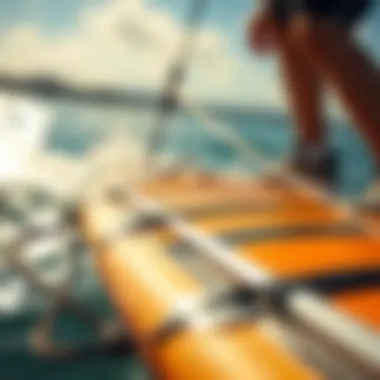

The Evolution of Water Sports
The field of water sports has always been in a state of flux, constantly adapting to advancements in technology and shifting cultural preferences. Understanding the evolution of these sports provides valuable context for innovations like e-foiling. Not only does it illustrate how human ingenuity transforms recreational activities, it also reflects broader social trends such as environmental consciousness and inclusivity. Today, as traditional kiteboarding meets emerging technologies, we stand at a pivotal crossroads in the world of water sports.
Historical Context
Water sports have roots that trace back thousands of years. From ancient cultures using simple rafts for fishing to the advent of sailing ships, humanity's relationship with water has been deeply intertwined with survival and exploration. Fast forward to the late 20th century, when the sport of kiteboarding gained traction, revolutionizing how we interact with water. This thrilling pastime combined elements of surfing, windsurfing, and paragliding, capturing the imagination of adventure seekers everywhere.
However, traditional kiteboarding has its limitations. Weather conditions, wind strength, and the sheer physicality required can deter many potential enthusiasts. It became clear that a more accessible option was needed, one that would allow beginners and seasoned riders alike to enjoy the sensation of gliding over water without barriers. That transition marked a crucial shift, laying the groundwork for innovations like e-foiling.
Technological Advancements
The technological leap that brought e-foiling to life is astounding. The introduction of electric propulsion systems created a whole new dynamic in water sports. Unlike traditional kiteboarding, where wind is the primary mover, e-foiling utilizes a quiet electric motor to lift the rider above the surface, leading to a unique cruising experience.
This technological marvel not only democratically expands accessibility but also minimizes the dependence on environmental conditions. Riders can enjoy a smooth ride in light winds or glassy waters, a game-changer for those who wish to hit the waves anytime.
Some key advancements in e-foiling technology include:
- Lightweight Materials: The use of carbon fiber and other lightweight composites allows for easier handling and enhanced performance.
- Smart Batteries: Modern lithium-ion batteries offer longer run times and faster charging, making e-foiling not just a sport, but a feasible leisure activity.
- User-Friendly Controls: Intuitive remote controls and monitoring apps have simplified the learning curve, allowing newbies to step up with confidence.
In essence, e-foiling bridges the gap between technology and tradition, offering a transformative experience that respects the roots of water sports while looking ahead to a sustainable future.
Benefits of E-Foiling
E-foiling is not just another kiteboarding trend; it’s a significant shift in how we engage with water sports. This innovation brings together cutting-edge technology and the age-old thrill of flying above the water, all while offering several advantages that resonate with both seasoned athletes and laypersons just dipping their toes into the sport. The benefits of e-foiling are manifold, with accessibility, excitement, and environmental consciousness taking the forefront.
Accessibility for Beginners
One of the key aspects of e-foiling is its ability to open up the exhilarating world of water sports to beginners. Historically, kiteboarding required a steep learning curve, often leaving newcomers feeling overwhelmed and discouraged. Yet, e-foiling turns the tables in a remarkable way.
By combining a stable board with a propulsion system, e-foils simplify the learning process dramatically. For instance, someone with no prior experience on the water can hop on, powered by the electric motor, and find themselves gliding smoothly on the surface in no time.
"E-foiling is like riding a bike but on water; you balance, feel the wind, and zoom away!"
The technology behind e-foils ensures a gentle lift that allows riders to float above the water with relative ease. That means you can focus on your balance and technique without the constant worry of wiping out. With just a few lessons, most beginners can feel comfortable enough to explore various conditions and locations, which encourages them to dive deeper into the sport.
In addition to the immediate thrill, there's the aspect of social inclusion. Many e-foiling communities are welcoming and eager to assist newcomers, making it easier to form connections and foster friendships within this vibrant sport.
Thrill of Flight
The sensation of soaring across water is arguably one of the most alluring features of e-foiling. Picture this: gliding above the waves, feeling a rush of freedom akin to flying. That’s precisely what you get when you embark on an e-foiling adventure. Unlike traditional kiteboarding, where skill and wind conditions can directly impact your experience, e-foiling provides a sense of liberation without many of those hindrances.
The thrill is magnified by the quiet hum of the electric motor, giving you the unique chance to immerse yourself fully in the environment. Whether you’re cruising along a calm lake or slicing through ocean swells, the adrenaline of rising above the water will induce joy and excitement in ways traditional water sports can’t quite match.
Many who participate in e-foiling report a profound connection to nature. With the wind in your face and vast water beneath your feet, it feels like you’re flying rather than simply riding a board. This unique sensation is a prime factor luring both young adventurers and seasoned water sports enthusiasts to the practice.
Environmental Considerations
In an era where ecological awareness is crucial, e-foiling presents a less invasive option for water sports aficionados. The electric motors used in e-foils are often designed for efficiency, minimizing fuel consumption and emissions. Unlike traditional water sports that require gas-powered boats, e-foils allow riders to glide without contributing to watercraft pollution. Therefore, you can indulge your passion without compromising the beauty of your surroundings.
Additionally, many manufacturers are tapping into sustainable practices to create e-foils. From the materials used for the boards to the batteries, there’s a growing awareness and commitment to eco-friendly options within the industry. This commitment means that participants in e-foiling can engage with a sport that values environmental protection alongside the thrill of flying.
In essence, embracing e-foiling means supporting a more sustainable future for water sports, making it an appealing choice for eco-conscious adventurers.
The benefits of e-foiling extend well beyond the mere thrill of being propelled across water. It champions inclusivity, offers a unique form of exhilaration, and aligns with the growing demand for environmentally friendly recreational activities. As more enthusiasts discover these advantages, the future of e-foiling in the water sports landscape looks promising.
Comparing E-Foiling to Traditional Kiteboarding
When discussing the impact of technology on sports, the comparison between e-foiling and traditional kiteboarding is quite significant. This comparison helps shed light on how advancements in equipment have transformed the experiences of both seasoned pros and beginners alike. While the thrill of kiteboarding is well-established, e-foiling introduces a new layer of engagement on the water that warrants careful consideration.
E-foiling harnesses the power of electric propulsion to lift riders above the water’s surface, seemingly transforming the mundane into something vivid and exhilarating. This is not merely a novel gadget; it's a potential paradigm shift in how enthusiasts approach water sports. Let’s delve deeper into the details.
Performance Metrics
Comparing performance metrics is a cornerstone in analyzing how e-foiling stacks up against traditional kiteboarding. Speed, maneuverability, and stability are critical aspects to look at.
- Speed: E-foils can achieve impressive speeds, reaching up to 25 miles per hour, depending on various factors such as the rider's weight and wind conditions. Traditional kiteboards, while also fast, often rely heavily on favorable wind conditions. This means e-foiling can be enjoyed in a broader range of scenarios.
- Maneuverability: E-foils offer a unique kind of agility. Riders have more control with an electric motor at their disposal, allowing for sharper turns and easier navigation through turbulent water. In traditional kiteboarding, maneuverability is more dependent on the wind and rider skill.
- Stability: The hydrofoil system used in e-foils can offer a more stable ride, especially for beginners. They lift out of the water, reducing drag and making for a smoother experience even in chop. In comparison, traditional kiteboards can be more challenging to balance, especially in tricky conditions.


These performance aspects collectively change the game for enthusiasts who seek versatility and excitement. E-foiling allows for exploration, often in conditions that might prove too tricky for traditional kiteboarding.
Skill Requirement Analysis
Analyzing the skill requirements to engage in each sport provides a fascinating perspective. While both activities demand practice and dedication, the learning curves are quite different.
- Beginner Friendliness: E-foils generally are more accessible to newcomers. With the aid of electric propulsion, new riders can focus on balance and navigation without needing to master wind dynamics from the get-go. Traditional kiteboarding requires an understanding of wind direction and kite control, which can be daunting for some.
- Advanced Skills: For those looking to elevate their proficiency, both sports have advanced techniques. In e-foiling, mastering speed control and landing tricks while airborne presents unique challenges. Conversely, kiteboarding focuses intensely on harnessing the kite for tricks and jumps, demanding a high level of coordination and timing.
- Physical Demands: E-foiling is often less physically taxing overall than kiteboarding. Riders can engage for longer periods without the constant battle against wind and waves, making it appealing for those who prefer a more relaxed experience.
Ultimately, the shift towards e-foiling could attract a different population of water sports enthusiasts. For some, it could serve as an introductory path into the world of kiteboarding, while for others, it could stand alone as a thrilling alternative.
In summary, the nuances between e-foiling and kiteboarding form an essential discussion on the evolving landscape of water sports. Each offers distinct experiences, with e-foils enhancing performance metrics and lowering accessibility barriers.
Essential E-Foiling Gear
When venturing into the thrilling world of e-foiling, having the right gear is not just an option—it’s a necessity. The right equipment can significantly enhance your experience on the water, making it not only safer but also more enjoyable. In this section, we will explore the different types of e-foils, discuss battery and charging considerations, and underline the safety gear essentials that every e-foiler should have.
Types of E-Foils
E-foils come in a variety of styles, each designed to meet different needs and preferences. Whether you’re a seasoned pro or just dipping your toes into the sport, here are the main categories:
- All-around E-Foils: These are versatile and suitable for most conditions, making them a great choice for beginners and casual riders. They often provide a balanced experience, combining speed stability and maneuverability.
- Surf E-Foils: Designed for those who want to catch waves, surf e-foils typically have a smaller wing size and are crafted to handle choppy water conditions. Riders who are into surfing can appreciate the unique feel they bring to the ride.
- Race E-Foils: Targeted at competitive riders, race e-foils focus on speed and efficiency. They're often lightweight and have streamlined designs, allowing for quicker takes off and impressive top speeds.
- Freestyle E-Foils: If you're looking to perform tricks and jumps, freestyle e-foils might be your best bet. These foils are built to withstand the rigors of tricks, with a flexible design that allows for impressive agility.
It's important to choose a foil that matches not just your skill level but also your riding style. For instance, opting for a more stable and easy-to-use foil as a beginner can set you up for success on the water.
Batteries and Charging Considerations
When it comes to the lifeblood of an e-foil, the battery is key. Most e-foils are powered by lithium-ion batteries, which provide a good balance of weight and energy density. Here’s what you need to keep in mind:
- Battery Capacity: The capacity of the battery is crucial—it determines how long you can ride before needing a recharge. Most batteries range from 50 to 100 Ah (Amp hours). Choosing a higher capacity battery allows for longer rides but tends to be heavier.
- Charging Speed: How fast your battery can charge is also important. Some chargers can fully charge a battery in about two hours, while others might take longer, making pre-ride planning essential.
- Regular Maintenance: Like any gear, batteries require maintenance. It's essential to store them properly, avoid letting them drain completely, and charge them according to the manufacturer's guidelines. This can extend their lifespan significantly, saving you money in the long run.
- Pro Tip: Having a spare battery can double your ride time, and it can be handy if you're planning a day on the water.
Safety Gear Necessities
Safety should always be a top priority in e-foiling. The right gear can protect you from injuries and ensure that you’re prepared for any unforeseen circumstances. Here’s a list of essential safety gear:
- Helmet: A well-fitted helmet protects your head from falls. Look for one specifically designed for water sports as they often have added features like drainage and ventilation.
- Impact Vest: An impact vest provides better buoyancy and can protect your torso from impacts. It’s wise to invest in a vest that fits snugly while allowing enough freedom of movement for your arms.
- Wet Suit: Depending on the water temperature, a wetsuit can keep you warm and protected. It also provides a second layer of defense against scrapes and cuts.
- Leash: A safety leash attaches you to your e-foil and is crucial for keeping the board from drifting away if you fall off.
- Personal Flotation Device (PFD): Depending on local regulations, wearing a PFD might be mandatory. Always check the local laws before setting out.
In summary, investing in quality e-foiling gear not only elevates your riding experience but also enhances safety on the water. When you feel secure with the right equipment, you can focus on mastering your skills and enjoying the ride. As the saying goes,
Safety Considerations in E-Foiling
E-foiling, while exhilarating, presents its own unique set of safety concerns that must be scrupulously addressed. The thrill of gliding above the water's surface can quickly turn into a precarious situation if proper precautions aren't taken. Being aware of these risks can not only protect the rider but also enhance the overall enjoyment of the sport. Thus, familiarizing oneself with safety considerations is a paramount step for anyone engaging in e-foiling.
Common Risks and Precautions
Like any exciting water sport, e-foiling has inherent hazards. Some of the most common risks include:
- Falling Off the Board: Riders can easily find themselves taken by surprise; losing balance can lead to a fall. Once off the board, a sudden contact with the water could cause injury or disorientation. Always wear a life vest for added safety.
- Collisions: The speed at which e-foils operate can lead to serious accidents if a rider collides with another board or an unseen obstacle. Keeping a safe distance from others is essential.
- Hydration and Sun Exposure: Spending ample time on the water can lead to dehydration and sunburn. Riders should remember to apply sunscreen liberally and drink plenty of water.
- Battery Risks: With electric components involved, there's always a risk of battery mishaps. Use only certified chargers and never leave a charging battery unattended.
Taking preventive measures can significantly reduce these risks. Here are some basic safety precautions:
- Wear Appropriate Gear: A life jacket, wetsuit, or impact vest can provide crucial protection.
- Know Your Limits: Before tackling advanced maneuvers or high speeds, ensure you are comfortable with the basic operations of the e-foil.
- Check Equipment Regularly: Before hitting the water, inspect the board, battery, and other gear to avoid technical failures.
- Choose Your Location Wisely: Opt for areas with minimal boat traffic and easy access should an emergency arise.
Importance of Proper Training
Training plays an indispensable role in ensuring safety while e-foiling. Just because you can ride a traditional surfboard doesn’t mean you can jump onto an e-foil without preparation. Learning the ropes from experienced instructors can greatly reduce the likelihood of accidents.
- Understanding the Mechanics: Novices often underestimate the complexities of e-foils, including handling and propulsion. A proper training program can reveal vital information about how to operate the board safely.
- Knowledge of the Environment: Recognizing water currents, tides, and weather conditions is crucial for safe e-foiling. Training sessions often encompass lessons on how to read these variables effectively.
- Emergency Procedures: Being prepared for emergencies can save lives. Training typically covers how to reposition the board and react swiftly in case of a mishap.
Embracing safety in e-foiling isn’t just about keeping oneself out of harm’s way; it’s about fostering a culture of responsibility and awareness in the e-foiling community.
"Safety isn’t just a guideline; it’s the backbone of every adventure on water."
While the thrill of the ride is undeniable, giving precedence to safety ensures that these exhilarating experiences remain enjoyable and sustainable.
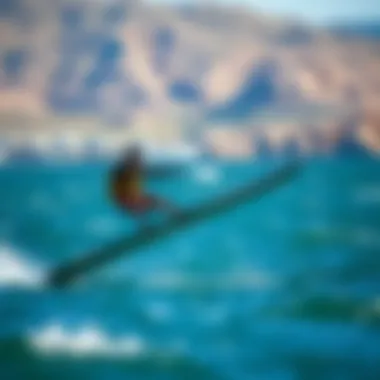

For further information about e-foiling safety practices, you may find helpful resources at nssia.org or local e-foil communities on platforms like reddit.com and facebook.com.
Local E-Foiling Conditions
When it comes to e-foiling, the environments in which enthusiasts ride can make all the difference. Knowing the local conditions can mean the difference between a thrilling session on the water and a frustrating experience. Beyond just picking a location, understanding variables like wind patterns, water depth, and currents are crucial.
Best Locations for E-Foiling
E-foiling can be enjoyed in various locations, but certain spots stand out due to their unique conditions. Here are some prime locations where e-foiling thrives:
- Malibu, California: Known for its beautiful coastlines and consistent surf, Malibu offers flat waters in the morning that later transform into playful waves.
- The Keys, Florida: With its warm weather and shallow waters, the Florida Keys provide an ideal playground for anyone looking to take to the skies (or, better yet, the water) without the pesky waves.
- Lake Tahoe, Nevada/California: High-altitude lakes like Tahoe boast breathtaking scenery and calm water, presenting a serene experience for e-foilers.
- Danube River, Austria: When you're looking for something different, consider the Danube. The river's size allows for ample space, and the views of historical architecture add to the charm.
- Sydney Harbour, Australia: Gliding past the Opera House and Harbour Bridge can be an exhilarating experience, especially when the wind is just right.
Each of these locations has its own character, bringing distinct benefits for riders, from stunning views to gentle conditions perfect for beginners.
Seasonal Considerations
Understanding the seasonal trends in an area is essential for both novices and veterans of e-foiling. Depending on the time of year, local weather can present unique challenges and benefits. Here’s what to keep in mind:
- Summer: Generally regarded as the best time for e-foiling, summer offers warmer water and often more consistent weather patterns. The sun is shining, and e-foiling becomes a popular social activity, encouraging the growth of community.
- Fall: As temperatures cool down, many locations might offer fewer crowds. Wind patterns often change, which could either make for more challenging e-foiling conditions or present exciting new opportunities for thrill-seekers.
- Winter: Chilly water can deter many, but the more adventurous spirits can still find enjoyment. Gear up with a good wetsuit, and look for areas that maintain a moderate level of wind speeds. In some cases, winter can provide the calmest days on the water.
- Spring: This season can be unpredictable. One day might be perfect for flying, while the next could see turbulent winds. Riders should stay alert and in tune with local forecasts to make the most out of sporadic weather patterns.
Understanding the elements of local e-foiling conditions not only enriches the riding experience but encourages a stronger sense of community among enthusiasts. Riders can share tips, tricks, and hot spots, facilitating a culture that appreciates and enhances the sport as a whole.
"To fly is to be free, but knowing your environment is the key to soaring."
For more insights, consider visiting community platforms like Reddit or checking local weather evaluations at NOAA for the best experience on the water.
E-Foiling Community and Culture
E-foiling isn't just about the tech or the thrill; it's about the people who bring the sport to life. This community circles the globe, from local lakes to the expansive ocean, binding individuals with shared passions and experiences. Connecting with fellow enthusiasts not only enriches the e-foiling experience but also fosters growth and innovation within the sport.
Building Connections
In any sport, forming connections is vital. E-foiling is no different. Through social media platforms like Facebook or dedicated forums on Reddit, enthusiasts share tips, stories, and even gear recommendations. These communities create a sense of camaraderie. They can range from organized meet-ups at popular e-foiling locations to informal gatherings at local beaches. Being part of this community opens the doors to opportunities that one might not even be aware of.
Whether it’s chatting with someone about the latest e-foil model or exchanging ideas for perfecting technique, these interactions can lead to lifelong friendships. Knowledge sharing is key. Newcomers can get tips from experienced e-fliers or learn about safety precautions that might not be clearly documented elsewhere.
Sharing Experiences and Knowledge
The essence of any thriving community lies in the sharing of experiences and knowledge. E-folers often recount their adventures, which can range from breathtaking sunrises on desolate beaches to unexpected encounters with marine life. Such stories not only inspire others but also build a deeper appreciation for the sport itself.
Workshops and tutorials are another way knowledge circulates within the e-foiling community. Experts might host events that cover a variety of topics, from mastering the controls of the e-foil to understanding battery management. These gatherings serve as educational hubs where both novices and veterans can acquire skills needed to improve their performance.
Sharing knowledge is how we grow. As we exchange tips and stories, we lift the whole community up, creating a richer culture of e-foiling.
By participating in local clubs or online forums, e-foilers contribute to a growing repository of information. Many enthusiasts document their journeys through blogs or videos, showcasing milestones and lessons learned, thus paving the way for others to follow. In this culture, every new rider is welcomed warmly, and every small achievement is celebrated like a grand victory.
The e-foiling community is ever-evolving, marked by collective support and shared wisdom. Each connection made can lead to new adventures, pushing the boundaries of what’s possible in the sport. It's this dynamic and inclusive ethos that makes e-foiling not just a sport but a vibrant community.
The Future of E-Foiling
E-foiling stands at the precipice of a transformative wave in water sports. As advanced technology continues to resonate through various sporting disciplines, so too does it shape the future of e-foiling. Not merely a fleeting trend, e-foiling is set to grow in popularity and sophistication, creating pathways for both casual enthusiasts and skilled riders. The confluence of innovative engineering, sustainability efforts, and community expansion will play a central role in determining how this sport evolves.
Potential Innovations
The horizon looks promising, filled with potential innovations that could redefine e-foiling. First, improvements in battery technology will undeniably be at the forefront. Current batteries, while efficiently powering rides, have limited lifespan. Researchers and manufacturers are exploring high-capacity, lightweight batteries that could extend riding time significantly, while reducing overall weight.
Additionally, the integration of artificial intelligence can further enhance the experience. Imagine e-foils equipped with smart systems capable of adjusting performance based on conditions such as rider weight or water currents. Such advancements would not only boost efficiency but also enhance safety, making the sport more accessible to newcomers.
New materials are also on the cusp of being utilized in crafting lighter, sturdier boards. Advancements in carbon fiber technology, for instance, promise to reduce drag and improve maneuverability. These innovations can also mean better durability—helping riders spend more time on the water, and less time worrying about repairs.
- Increased battery capacity
- AI integration for personalized riding experiences
- Usage of advanced materials like carbon fiber
Impact on the Sport's Landscape
The impact of these innovations on the overall landscape of the sport is likely to be profound. As e-foiling gains traction, it has the potential to shift how individuals engage with water sports. Less experienced riders can find solace in the powered lift and stability that an e-foil offers, allowing them to step outside their comfort zones. Through this lens, e-foiling can become a bridge for many new individuals eager to enter the realm of kiteboarding without the intimidating steep learning curve.
As with many trends, shifts in community culture can’t be overlooked. It’s easy to envision e-foiling events burgeoning in both local pockets and large international gatherings, fostering camaraderie. Online communities—such as forums or social media groups—can facilitate knowledge exchange among riders. These interactions can help establish best practices, gather feedback about gear, and share experiences, enriching the e-foiling culture.
"E-foiling is not just about having fun on the water; it's about redefining what’s possible and creating connections among water sport enthusiasts."
In the long tail, e-foiling is set to carve out its niche in the annals of water sports. As technology and community intertwine over the years, one can only anticipate how far this evolution might carry those who seek the thrill of gliding above the water.


